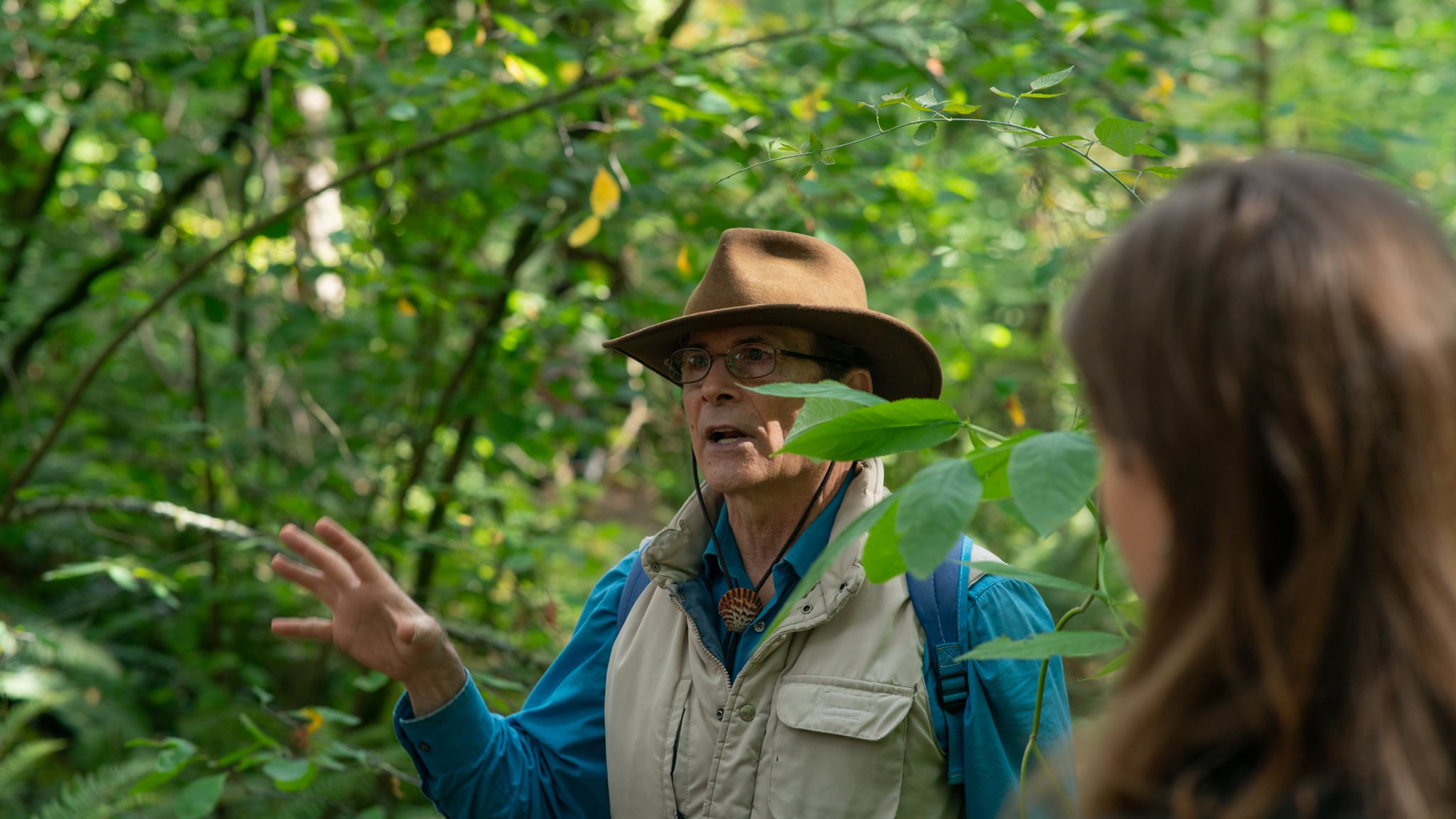At an undisclosed location in the middle of Forest Park, we pause to look up into the tall trees and slowly inhale the pine-perfumed air. Then our guide passes around a stem of wild ginger for us to smell and nibble on.
“Let’s just take a moment,” says wild food expert John Kallas, “to appreciate where we live.”
Our motley group has joined his outdoor workshop to learn the basics of winter foraging—essentially finding your own food—specifically for our region.
“Portland is like the mecca of wild foods,” he continues. “In the spring, our Northwest forests are like salad—literally just one big salad.”
During the wintertime, the local landscape for wild edible foods changes. In Portland’s evergreen valley, some fruits fall juicy and ready to consume, but many others require some processing to be palatable.
“Edible plants have one or more parts that can be used for food if you gather them at the appropriate stage of growth and properly prepare them,” Kallas explains. “If you don’t know those things, then you’re just going to goof yourself up at some point, poison yourself or, more likely, you’ll just have a miserable experience and give up.”
That’s not to say the Pacific Northwest ceases to be edible once the first freeze comes. There are still probably crab apples, persimmons and sumac (not the poisonous one) fruits to be found. But winter is also a wonderful time to start learning about wild edibles so that when spring arrives, you already have knowledge ready to employ.

Kallas says anyone just starting to forage wild food needs to have reasonable expectations and put in the time to build their knowledge: “They’re going to learn plants one by one, a step at a time. They’ll know when each is at its prime, and their expectations will be met. That’s when you develop a lifelong interest.”
He speaks earnestly to our group of around 15 people, finding ways to appeal to each person’s particular interest in the wild foods that surround us: Three tourists with limited English marvel at the juxtaposition of dense forest and the nearby downtown while enthusiastically nibbling the plants Kallas has passed to them, a woman shakes his hand and sweetly thanks him for creating a course that is so powerfully anti-capitalist and distinctly pro-community. Another lights up at every question addressed to the class—it’s not her first course with Kallas and it likely won’t be her last.
Kallas’ enthusiasm and expertise come from a combination of formal study, lived experience, and decades of teaching—blending nutrition training with hands-on plant identification and scientific research to pioneer accurate nutritional data for wild edibles.
“As a child, I was a romantic about living off the land,” he says. “Whole cultures were designed around food. All the tools you see in a museum—that’s all about food.”
Kallas’ early fascination with Indigenous ways and self-sufficiency sparked a lifelong interest in understanding how people lived from the land. In college, his curiosity became academic. He designed his own independent study on edible wild plants and paired it with formal nutrition and survival training—connecting scientific understanding with practical knowledge.
His academic trajectory culminated in a research focus on the nutritional science of wild plants, where he became a pioneer—producing the first accurate nutrient data for wild foods and becoming a foundational voice in the contemporary wild foods movement.
We asked Kallas to guide us through a winter foraging strategy that focused on both education and hands-on practice. Here was his advice:

Assess your environment carefully
Late into fall, Portland’s neighborhoods overflow with abundance—but always get consent before harvesting on private land. “You can forage for things that were formerly domesticated and are now sort of fallow in the neighborhood,” Kallas says. “But if it’s in a park or something, then you don’t have to worry.”
Old gardens, abandoned lots, and parks often harbor edible plants safely away from chemical use. Foragers can find plentiful greens and various tree fruits close to home, but Kallas reminds us always to forage ethically—and safely.
“Look at where the base of the plant is growing from,” advises Kallas. “If the base of the plant is in an area where it’s obvious that people are spraying, then those roots are going to take in that toxin as well.” Avoid areas where herbicides, pesticides or other chemicals might be used.
When foraging in forested areas of the Northwest, Kallas instructs his students to be aware of their surroundings beyond the flora beneath the canopy.
“You want to be a couple of yards away from any asphalt,” Kallas says. “If it’s cement, it doesn’t matter, but asphalt is a petroleum product. If it’s a highway, you want to be, you know, 50 feet from the road. And don’t collect anywhere near a railroad track because they’ve been spraying the tracks every year for 100 years.”
Bottom line: Kallas advises neighborhood foragers to prioritize safety, respect and awareness. For him, good local foraging is about knowing your surroundings as well as your plants.

Expect winter scarcity
Wild edibles are limited in winter. Foragers should respect seasonal cycles, turn to hardy perennial greens or stored foods, and accept that winter is largely a time for rest and preparation—both for plants and for people.
“Once the first freeze hits, everything starts dropping from the plants,” Kallas says. “Understand natural cycles: After freezing, berries ferment—the alcohol content increases to make it more fun for the birds—signaling the end of the foraging season for humans.”
That doesn’t mean there’s no foraging to be had in the winter months. Even in cold weather, Kallas says, he still gathers “dandelions, wild spinach and sorrel” from his garden, noting that “they grow without me doing much to them.”
During his workshops, Kallas introduces his students to sumac, hawthorn berries, crab apples and honey locust pods. While these are all edible as they are, Kallas treats the astringent berries and apples as ingredients for processing, not fresh eating—turning them into jams, juices or stored products to extend their use through winter.
“A lot of times what I’ll do is take the fruit and preserve it. Then I can use it any way I want later,” Kallas says. “I’m not making a jam out of everything, though. I can only eat so much jam.”
Bottom line: Accept that winter is primarily a season of rest, reflection and preparation rather than active harvesting.

Prepare for springtime
Foragers should accept that most wild foods have completed their natural cycle during winter and focus on other parts of the practice, like building their personal foraging library or database. Winter is the perfect time to refine technical knowledge by studying plant and identification materials. Aspiring foragers can also use this season to become acquainted with plants unique to their area at all stages of growth, building a personal library and then employing that knowledge to prepare a foraging calendar for spring.
“My book, Edible Wild Plants: Wild Foods from Dirt to Plate, covers 15 of the most common wild edible plants in North America,” Kallas says. “Each chapter is a complete course on that plant—what it looks like, where it grows, what parts are edible, how to prepare them, and what they taste like.
“I wrote it to be practical. I wanted people to be able to go outside, find a plant and know exactly what to do with it from the ground to the table.”
Bottom line: Winter is ideal for education and planning—refining knowledge and organizing what to forage when growth returns in spring.
Learn more about John Kallas’ in-person workshops at wildfoodadventures.com.
Oregon Winter is Willamette Week’s annual winter activity magazine. It is free and can be found all over Portland beginning Friday, November 21, 2025. Find your free copy at one of the locations noted here, before they all get picked up.

